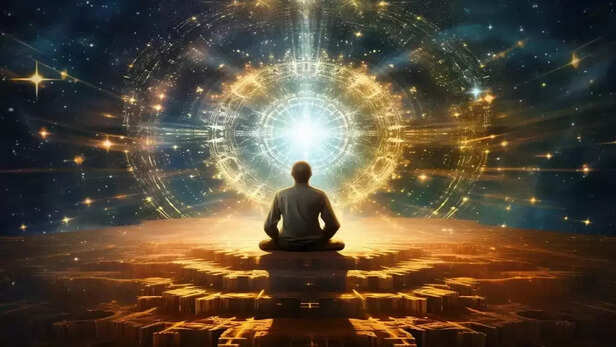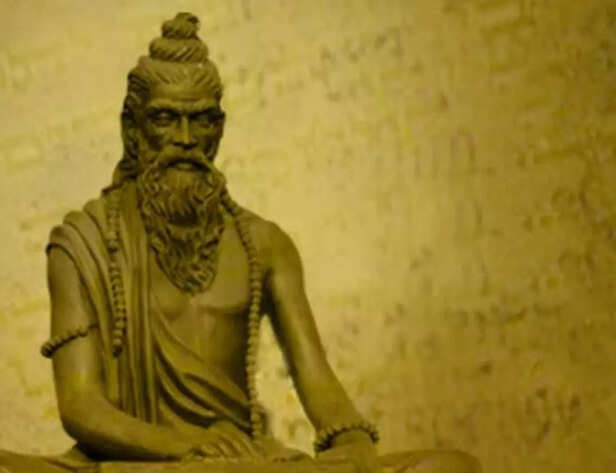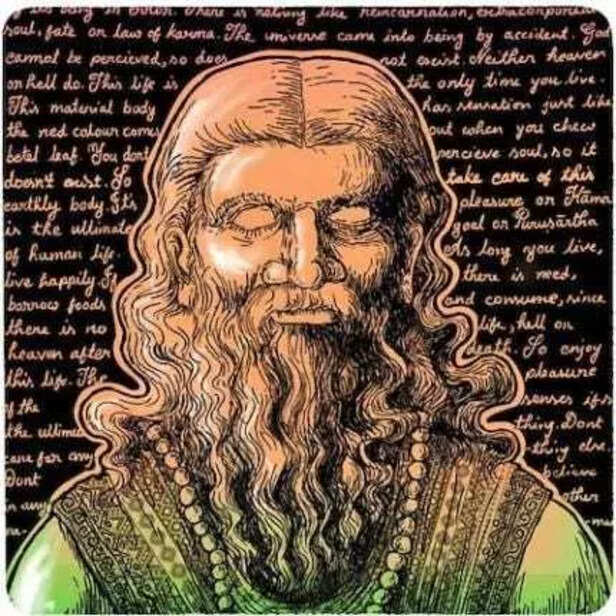Man Is a Machine Until He Begins to Observe Himself—The Gita Unfolds the True Nature of Man
Ankit Gupta | May 19, 2025, 23:43 IST
In the chaos of modern life, where actions are governed by impulses, patterns, and programming, an ancient voice arises from the depths of Hindu wisdom. It whispers not condemnation, but a path: “You are not your actions, not your habits, not even your thoughts. You are the silent observer within.”
“यदा यः पश्यति नान्यं, सदा आत्मानमेव पश्यति, तदा साक्षात्करोति ब्रह्म”
(When one ceases to see the many and sees only the Self everywhere, then one realizes Brahman.)
— Brihadaranyaka Upanishad
The modern mystic G.I. Gurdjieff said, “Man is a machine until he begins to observe himself.” While he spoke in the language of modern psychology and esoteric philosophy, this truth lies at the very heart of Hindu Dharma—echoing through the Upanishads, Bhagavad Gita, and Yoga philosophy. Hindu scriptures have long emphasized that the unexamined life is not merely unconscious but bound by prakriti (nature), karma (action), and maya (illusion). Without self-awareness (atma-vichara), man is indeed a machine—bound to repeat samsaric patterns.

The vision of life recognizes three gunas—sattva (clarity), rajas (activity), and tamas (inertia)—as the fundamental tendencies that shape all behavior. These are not just cosmic principles but internal energies that govern human thought, feeling, and action.
As long as a person is under the sway of these gunas without self-inquiry, he is nothing but a puppet of prakriti.
“प्रकृतेः क्रियमाणानि गुणैः कर्माणि सर्वशः।
अहंकारविमूढात्मा कर्ताहमिति मन्यते॥”
“All actions are performed by the gunas of nature, but the deluded one, ego-bound, thinks, 'I am the doer.'”
— Bhagavad Gita 3.27
This verse reveals the essential machine-like nature of human life when lived in ignorance (avidya). The ego mistakenly believes it is in control, when in fact, it is compelled by unconscious impulses, habits, and vasanas (latent tendencies from past lives).
Thus, man, in his ordinary state, is mechanical—moved by karma, responding automatically to external events, enslaved by his own past conditioning.

If the bondage is mechanical, the liberation must be conscious. The moment a man begins to observe himself, he rises above prakriti and begins to touch purusha—the unchanging, observing consciousness.
The Katha Upanishad describes the self as a charioteer, the senses as horses, and the mind as reins. Most people, it says, let the senses run wild, leading to destruction. But the wise one observes, restrains, and guides.
“आत्मानं रथिनं विद्धि शरीरं रथमेव तु।
बुद्धिं तु सारथिं विद्धि मनः प्रग्रहमेव च॥”
— Katha Upanishad 1.3.3
This imagery suggests that unless a man is conscious of the direction of his life, he is no more than a machine dragged by his own senses. Observation is the beginning of mastery.
The Bhagavad Gita repeatedly calls on Arjuna to become a sakshi—a witness.
“उदासीनवदासीनो गुणैर्यो न विचाल्यते।
गुणा वर्तन्त इत्येव योऽवतिष्ठति नेङ्गते॥”
“The one who remains like a witness, unmoved by the gunas, who knows they alone are active—he indeed is free.”
— Bhagavad Gita 14.23
The Gita here defines the liberated man not by external action, but by inner observation—a man who watches the play of the gunas without identifying with them.
This is exactly the turning point Gurdjieff alludes to: man ceases to be a machine the moment he becomes aware that the machine is operating.

The Yoga Sutras of Patanjali, one of the six classical darshanas of Hindu philosophy, explicitly begins by stating that Yoga is the cessation of mechanical mental patterns.
“योगश्चित्तवृत्तिनिरोधः”
“Yoga is the stilling of the fluctuations of the mind.”
— Yoga Sutras 1.2
What are these vrittis (fluctuations)? They are the automatic reactions, mental chatter, emotional oscillations—the machinery of the mind. Without yoga, man is simply responding to these patterns, mistaking them for himself.
But through self-observation (svadhyaya) and meditation (dhyana), the yogi begins to witness these patterns, and in doing so, he detaches. This detachment is not emotional withdrawal, but a higher engagement—from the plane of purusha, not prakriti.
The Mandukya Upanishad introduces the idea of Turiya, the fourth state beyond waking, dreaming, and deep sleep. It is pure awareness, the silent observer of all states.
Until one is conscious in this state, one is tossed between jagrat (waking), swapna (dream), and sushupti (deep sleep), like a machine moving in cycles. To abide in Turiya is to escape the machine.
In Hindu thought, karma is often seen as a self-operating mechanism. Every action plants a seed. Every seed gives rise to future circumstances. Without viveka (discrimination) and vairagya (detachment), man is caught in an endless cycle.
“जातस्य हि ध्रुवो मृत्युर्ध्रुवं जन्म मृतस्य च।”
“For one who is born, death is certain, and for the dead, birth is certain.”
— Bhagavad Gita 2.27
This cycle—samsara—is powered not just by actions, but by unconsciousness. The man who does not observe himself keeps returning to life not by divine punishment, but by mechanical inertia.
Observation of the self begins to break the karmic momentum, because it introduces choice where once there was only compulsion.
Ramana Maharshi, echoing the Advaita tradition, taught the direct path of self-inquiry by the question “Who am I?” Every time a thought arises, one must trace it back to its source—the “I” that witnesses all.
“The body does not say 'I'. The mind does not say 'I'. The real ‘I’ is the witness of both.”
— Ramana Maharshi
Through constant observation, the jnani comes to rest in the unchanging self, beyond the machinery of mind and body.
The Gita’s Karma Yoga is not merely about selfless service; it’s about acting without identification. The practitioner acts as an instrument of the Divine, observing his own reactions, and letting go of the fruits.
“योगस्थः कुरु कर्माणि सङ्गं त्यक्त्वा धनञ्जय।
सिद्ध्यसिद्ध्योः समो भूत्वा समत्वं योग उच्यते॥”
— Bhagavad Gita 2.48
“Be steadfast in yoga, O Arjuna. Perform your duties, abandoning attachment to success and failure. This equanimity is Yoga.”
Even the path of devotion involves observation—of one's emotions, attachments, and desires. The bhakta watches his longing, surrenders it, and through love, becomes absorbed in the divine. This too is a path from mechanical ritual to living relationship.

When the seeker observes enough, questions enough, surrenders enough, the machinery of illusion begins to break down. What is revealed is the Self (Atman)—unchanging, eternal, conscious.
“न जायते म्रियते वा कदाचित्...”
“The Self is never born, nor does it die.”
— Bhagavad Gita 2.20
The man who knows this Self is no longer a machine. He is free—not in body alone, but in consciousness. He acts, yet is untouched. He feels, yet is not shaken. He lives in the world, but is no longer bound by it.
The idea that man is a machine until he begins to observe himself is not foreign to Hindu thought. It is, in fact, its very foundation. The scriptures speak again and again of the necessity of awareness, of the inner shift from identification to witnessing, from reactivity to consciousness.
Whether through Vedanta, Yoga, Bhakti, or Karma—the destination is the same: to awaken from the slumber of prakriti and realize the purusha within.
Man, in his sleeping state, is a wheel turning on the axis of karma and desire. But the moment he stops, watches, and questions—that moment, he ceases to be a machine.
He becomes the seer, the knower, the Self.
(When one ceases to see the many and sees only the Self everywhere, then one realizes Brahman.)
— Brihadaranyaka Upanishad
The modern mystic G.I. Gurdjieff said, “Man is a machine until he begins to observe himself.” While he spoke in the language of modern psychology and esoteric philosophy, this truth lies at the very heart of Hindu Dharma—echoing through the Upanishads, Bhagavad Gita, and Yoga philosophy. Hindu scriptures have long emphasized that the unexamined life is not merely unconscious but bound by prakriti (nature), karma (action), and maya (illusion). Without self-awareness (atma-vichara), man is indeed a machine—bound to repeat samsaric patterns.
What Does It Mean to Be a Machine?

Image Credit: Pexels
The vision of life recognizes three gunas—sattva (clarity), rajas (activity), and tamas (inertia)—as the fundamental tendencies that shape all behavior. These are not just cosmic principles but internal energies that govern human thought, feeling, and action.
As long as a person is under the sway of these gunas without self-inquiry, he is nothing but a puppet of prakriti.
“प्रकृतेः क्रियमाणानि गुणैः कर्माणि सर्वशः।
अहंकारविमूढात्मा कर्ताहमिति मन्यते॥”
“All actions are performed by the gunas of nature, but the deluded one, ego-bound, thinks, 'I am the doer.'”
— Bhagavad Gita 3.27
This verse reveals the essential machine-like nature of human life when lived in ignorance (avidya). The ego mistakenly believes it is in control, when in fact, it is compelled by unconscious impulses, habits, and vasanas (latent tendencies from past lives).
Thus, man, in his ordinary state, is mechanical—moved by karma, responding automatically to external events, enslaved by his own past conditioning.
The Path of Self-Observation

From Mechanical to Conscious Living
If the bondage is mechanical, the liberation must be conscious. The moment a man begins to observe himself, he rises above prakriti and begins to touch purusha—the unchanging, observing consciousness.
a) The Witness in the Upanishads
“आत्मानं रथिनं विद्धि शरीरं रथमेव तु।
बुद्धिं तु सारथिं विद्धि मनः प्रग्रहमेव च॥”
— Katha Upanishad 1.3.3
This imagery suggests that unless a man is conscious of the direction of his life, he is no more than a machine dragged by his own senses. Observation is the beginning of mastery.
b) The Gita’s Call to Inner Detachment
“उदासीनवदासीनो गुणैर्यो न विचाल्यते।
गुणा वर्तन्त इत्येव योऽवतिष्ठति नेङ्गते॥”
“The one who remains like a witness, unmoved by the gunas, who knows they alone are active—he indeed is free.”
— Bhagavad Gita 14.23
The Gita here defines the liberated man not by external action, but by inner observation—a man who watches the play of the gunas without identifying with them.
This is exactly the turning point Gurdjieff alludes to: man ceases to be a machine the moment he becomes aware that the machine is operating.
Yoga and the Cessation of Mechanical Activity

Patanjali
The Yoga Sutras of Patanjali, one of the six classical darshanas of Hindu philosophy, explicitly begins by stating that Yoga is the cessation of mechanical mental patterns.
“योगश्चित्तवृत्तिनिरोधः”
“Yoga is the stilling of the fluctuations of the mind.”
— Yoga Sutras 1.2
What are these vrittis (fluctuations)? They are the automatic reactions, mental chatter, emotional oscillations—the machinery of the mind. Without yoga, man is simply responding to these patterns, mistaking them for himself.
But through self-observation (svadhyaya) and meditation (dhyana), the yogi begins to witness these patterns, and in doing so, he detaches. This detachment is not emotional withdrawal, but a higher engagement—from the plane of purusha, not prakriti.
Turiya—The Fourth State
Until one is conscious in this state, one is tossed between jagrat (waking), swapna (dream), and sushupti (deep sleep), like a machine moving in cycles. To abide in Turiya is to escape the machine.
The Machinery of Karma—Cycle Without Observation
“जातस्य हि ध्रुवो मृत्युर्ध्रुवं जन्म मृतस्य च।”
“For one who is born, death is certain, and for the dead, birth is certain.”
— Bhagavad Gita 2.27
This cycle—samsara—is powered not just by actions, but by unconsciousness. The man who does not observe himself keeps returning to life not by divine punishment, but by mechanical inertia.
Observation of the self begins to break the karmic momentum, because it introduces choice where once there was only compulsion.
Techniques from Hindu Dharma for Self-Observation
a) Jnana Yoga – Atma Vichara (Self-Inquiry)
“The body does not say 'I'. The mind does not say 'I'. The real ‘I’ is the witness of both.”
— Ramana Maharshi
Through constant observation, the jnani comes to rest in the unchanging self, beyond the machinery of mind and body.
b) Karma Yoga – Witnessing in Action
“योगस्थः कुरु कर्माणि सङ्गं त्यक्त्वा धनञ्जय।
सिद्ध्यसिद्ध्योः समो भूत्वा समत्वं योग उच्यते॥”
— Bhagavad Gita 2.48
“Be steadfast in yoga, O Arjuna. Perform your duties, abandoning attachment to success and failure. This equanimity is Yoga.”
c) Bhakti Yoga – Witnessing Through Love
The State Beyond the Machine—Realization of the Self

Idolizing the Only Self
When the seeker observes enough, questions enough, surrenders enough, the machinery of illusion begins to break down. What is revealed is the Self (Atman)—unchanging, eternal, conscious.
“न जायते म्रियते वा कदाचित्...”
“The Self is never born, nor does it die.”
— Bhagavad Gita 2.20
The man who knows this Self is no longer a machine. He is free—not in body alone, but in consciousness. He acts, yet is untouched. He feels, yet is not shaken. He lives in the world, but is no longer bound by it.
The Journey from Samsara to Sakshi
Whether through Vedanta, Yoga, Bhakti, or Karma—the destination is the same: to awaken from the slumber of prakriti and realize the purusha within.
Man, in his sleeping state, is a wheel turning on the axis of karma and desire. But the moment he stops, watches, and questions—that moment, he ceases to be a machine.
He becomes the seer, the knower, the Self.
